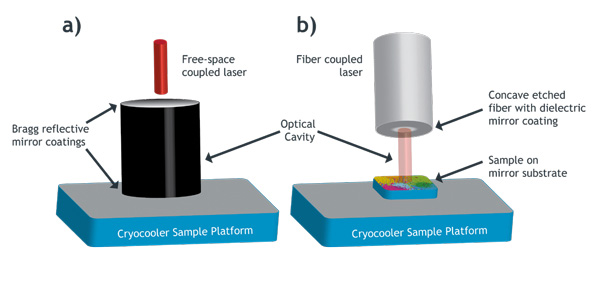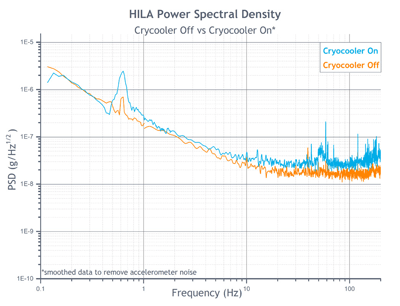
Free-beam-coupled (left) and fiber-coupled (right) resonator
Optical cavities (resonators) are a very versatile way to manipulate optical emissions. The cavity’s microstructures supply optical gain, can stabilize a laser’s line width and influence the spontaneous emission range of a material in the resonator. Optical cavities are frequently used in fundamental research to study the interactions between materials and electromagnetic waves, especially in quantum transport experiments.
Cavity performance depends on many factors like Q-factor (optical quality factor), input coupling losses and internal losses. Each of these factors improves with cryogenic temperatures, high temperature stability and low vibrations. At room temperature, a large number of phonons are excited. As a result, the zero-phonon transition, a purely optical transition without interactions with lattice vibration which is important for quantum transport experiments, is almost zero. The lower the temperature, the lower the phonon population, the higher the probability of a purely optical transition. To adapt the resonators to the wavelength of the used light, it is feasible to regulate the mirror distance through a positioning platform. At lower temperatures, this experimentally versatile design is especially prone to vibrations. Commercial low-temperature positioners have a low resonance frequency which is relatively close to the frequency at which common cold heads work. Vibrations on the cavity are intensified accordingly. The distance between the mirrors varies so that it is tuned to the used wavelength in only a limited way. To receive reasonable results, an RMS stability of < 0.5 nm between both mirrors is needed. Continuous-flow and bath cryostats have no movable parts and by nature show only very few vibrations. They are used less and less due to high helium costs, short experimental times and limited temperature control.

Vibration isolation of the new HILA cryostat from Montana Instruments. The system shows only little higher acceleration when the cold head is in operation (blue graph) compared to when the system is not in operation (orange graph).
The key requirement for measurements on optical cavities is low acceleration of the experimental platform. As long as fibers are used, the vibration amplitude is not important. Acceleration is the main factor. The HILA cryostat decouples the cold head movements from the sample chamber.
With the HILA cryostat, Montana Instruments (MI) have developed a groundbreaking way to decouple the cold head movements from the sample chamber. The HILA cryostat has been available since the end of 2017.
It features several vibration isolation levels. Its core is the spring-mounted 4 K sample platform that ensures extremely low natural frequency (<0.6 Hz). As the platform oscillates very slowly with amplitudes of a few micrometers, MI is currently working on a beamline module that will allow the use of both fiber optics and free beam optics.



